As anyone who has read my blog knows, I am a great fan of gardens if not always of gardening. Since I am unable to do the strenuous work for more than a few minutes as a time, my role tends to be on the planning and planting side with a side-line in bindweed reduction. No, that’s not true. Almost all my gardening is the battle against bindweed and the bindweed is winning.
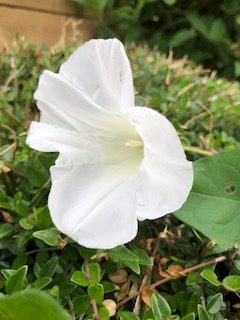
Image: Karen Costello-McFeat
When a friend told me that bindweed flowers can be removed with a satisfying flourish when pinching the base, I have entertained myself like the Queen of Hearts in Alice in Wonderland declaring ‘Off with your heads’ as I decapitate the offenders.
Since gardening is such hard work, I have come to the decision that those plants rescued from the fate of strangulation by bindweed and starvation due to the greedy invasion of other plants, ought to give something in return. They should, in other words, be edible.
Here we go round the mulberry bush
A couple of years ago, we decided to plant fruit trees in our vegetable patch as part of our forest garden. Not seeing much point in planting the usual fare, I opted for a mulberry, plums and a quince.
Mulberries are a favourite of mine and we regularly picked them from an ancient tree in our local park. Unfortunately, my desire to educate all the little kids about the marvels of mulberries led to them picking them and then their friends picking them too. Sadly, now there are very few to be had, but quite a lot of purple stained children.
Mulberries are slow growing trees and I didn’t expect fruits for many more years; however, I was pleasantly surprised this year to see the tree bursting with tiny berries. They are now picked and stored in the freezer, waiting for a the time when I can combine them with apples to make jam.
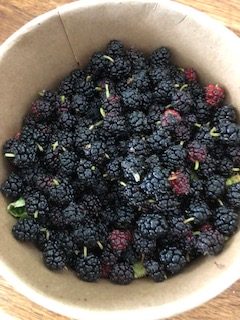
Image: Karen Costello-McFeat
The joy of trees
The joy of trees is unquestionably that they are extremely low maintenance and often provide the greatest amount of produce. My huge apple tree gives me enough apples to last the year and requires only the occasional pruning. I hope my new additions will soon do the same.
Whilst I applaud the Queen’s initiative to plant trees, I suspect that establishing fruit trees would be even better. After all, they provide the same environmental benefits regarding absorbing carbon emissions and providing natural habitats. But fruit trees also lower food costs and reduce air miles.
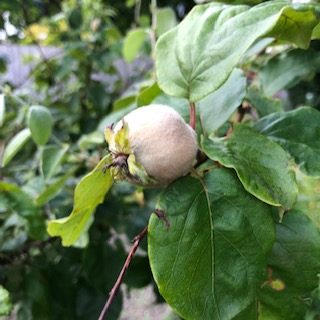
Even small gardens can have fruit trees in dwarf varieties or in pots. Personally, I would love to turn my lawn into orchard, but my long suffering husband suspects that it would make mowing the lawn an even greater chore. Perhaps we should just go for meadow?
Fruit canes and strawberries
For those who still think that trees are just too big, fruit canes like raspberries, currants and gooseberries hardly take up much space and can be planted alongside taller, flowering plants. (I don’t believe in segregating plants.) Strawberries are perfect in pots and hanging baskets and though I seldom get enough for anything at all, the few I ‘steal’ taste sweeter than any other.

Image: Karen Costello-McFeat
The herb garden
No garden should be without herbs. They are the most forgiving of plants and most pop up year after year without complaint or expectations of special treatment. You can grow them on the window sill, on the patio and in the beds. I have planted numerous mints in the hope that they will provide excellent ground cover and endless leaves for mint tea.
Herbs, for me, are what make salads special. Almost all herbs find their way into my salads and the addition of mint, which was recommended by a friend, is especially delicious. Rocket, which grows extravagantly in my garden, makes a much more interesting salad than a pale iceberg lettuce. A word of warning though: this is as enthusiastic a grower as bindweed and transplants itself with abandon. We even found some in our front garden, over a hundred feet from where they were originally sown.
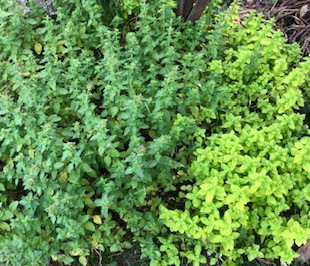
Image: Karen Costello-McFeat
Herbs have the additional benefits being pollinator friendly while at the same time putting off unwanted pests. Strong scents act as a deterrent to invasive insects including mosquitos.
Though most of my herbs are flourishing in all but the coldest of weather, I usually pick and dry them after the summer is passed. They only need to be tied and hung upside down in a paper bag (to avoid dust and dirt) and then rubbed off the stems when fully dry. Many herbs freeze well too, so if you have invested in more of an expensive herb than you can use immediately, consider freezing the rest. (Check how to best freeze which herb.)
Floral delights
Of course, few things compete with edible flowers, which offer both beauty and subtle flavour additions. When the rocket or broccoli bolts, we eat the delicate yellow flowers. When the lavender has just gone past its peak, I often dry the stems for perfume or flavour.
Rose geraniums are my favourites and make exquisite rose geranium gin (made in essentially the same way as sloe gin). A culinary genius friend suggested using the larger leaves on the bottom of a cake tin instead of lining paper to give a Victoria sponge a delicate floral taste.
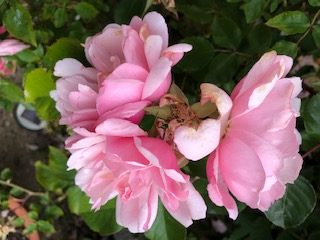
Roses are a wonderful source of colour and flavour. Rose waters make a gorgeous addition to fruit salad and the petals can be made into jam or used to decorate cakes. Only organic and unsprayed roses should be used (as I would recommend for all other edibles).
And if you forget to pick them in time? Rose hips, especially those from wild, climbing roses can be used for syrups or just eaten like foraged sweets.
So now I have finished this, I’m off to visit my garden and see what treats it holds in store.
